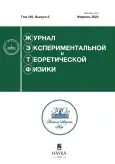ON THE THEORY OF HOMOGENEOUS NUCLEATION OF INCOHERENT INCLUSIONS IN SOLID SOLUTIONS
- Autores: Veshchunov M.S.1
-
Afiliações:
- Nuclear Safety Institute (IBRAE), Russian Academy of Sciences
- Edição: Volume 165, Nº 2 (2024)
- Páginas: 214-225
- Seção: Articles
- URL: https://journals.rcsi.science/0044-4510/article/view/256481
- DOI: https://doi.org/10.31857/S004445102402007X
- ID: 256481
Citar
Resumo
Based on a critical analysis of the traditional theory of homogeneous nucleation of incoherent precipitates of a new phase in solid solutions, it is shown that the elastic energy associated with a difference in the atomic volumes of two phases does not contribute to the nucleation barrier due to the absorption of thermal point defects at the particle-matrix interface (in contrast to the traditional approach). Correspondingly, a new kinetic model is developed for the rate of nucleation of incoherent precipitates in a supersaturated solid solution of alloying atoms, which has also been generalized to take into account excess vacancies formed under non-equilibrium conditions of quenching tests.
Palavras-chave
Sobre autores
M. Veshchunov
Nuclear Safety Institute (IBRAE), Russian Academy of Sciences
Autor responsável pela correspondência
Email: msvesh@gmail.com
Rússia, 115191, Moscow
Bibliografia
- R.W. Balluffi, S.M. Allen, and W.C. Carter, Kinetics of Materials, John Wiley and Sons (2005).
- R.E. Smallman and A.H.W. Ngan, Physical Metallurgy and Advanced Materials, 7th ed. Elsevier (2007).
- J.W. Christian, The Theory of Transformations in Metals and Alloys, Pergamon, Oxford (1975). 224
- D. Turnbull, H.S. Rosenbaum, and H.N. Treaftis, Kinetics of Clustering in Some Aluminium Alloys, Acta Metallurgica 8, 277 (1960).
- H.S Rosenbaum and D. Turnbull, On the Precipitation of Silicon out of a Supersaturated Aluminum-Silicon Solid Solution, Acta Metallurgica 6, 653 (1958).
- H.S. Rosenbaum and D Turnbull, Metallographic Investigation of Precipitation of Silicon from Aluminum, Acta Metallurgica 7, 664 (1959).
- E. Ozawa and H. Kimura, Excess Vacancies and the Nucleation of Precipitates in Aluminum-Silicon Alloys, Acta Metallurgica 18, 995 (1970).
- E. Hornbogen and E. A. Starke Jr., Theory Assisted Design of High Strength Low Alloy Aluminum, Acta Metallurgica et Materialia 41, 1 (1993).
- F.R.N. Nabarro, The Influence of Elastic Strain on the Shape of Particles Segregating in an Alloy, Proc. Phys. Soc. 52, 90 (1940).
- H. Mehrer, Diffusion in Solids: Fundamentals, Methods, Materials, Diffusion-Controlled Processes, Springer Series in Solid State Science, Vol. 155, Springer (2007).
- K.C. Russel, The Role of Excess Vacancies in Precipitation, Scripta Metallurgica 3, 313 (1969).
- M. Volmer and A. Weber, Keimbildung in ¨ Ubers¨attigten Gebilden, Z. Phys. Chem. 119, 277 (1926).
- R. Becker and W. Doering, Kinetische Behandlung der Keimbildung in ¨ Ubers¨attigten D¨ampfen, Ann. Phys. 24, 719 (1935).
- Ja.B. Zeldovich,On the Theory of New Phase Formation: Cavitation, Acta Physicochim. URSS 18, 1 (1943).
- H. Reiss, The kinetics of Phase Transitions in Binary Systems, J. Chem. Phys. 18, 840 (1950).
- A. Katok and B. Hasselblatt, Introduction to the Modern Theory of Dynamical Systems, Cambridge University Press, Cambridge (1995).
- J.S. Langer, Statistical Theory of the Decay of Metastable States, Annals of Physics 54, 258 (1969).
- D. Stauffer, Kinetic Theory of Two-Component, Nucleation and Condensation, J. Aerosol Sci. 7, 319 (1976).
- L.M. Berezhkovskii and V.Yu. Zitserman, Direction of the Nucleation Current through the Saddle Point in the Binary Nucleation Theory and the Saddle Point Avoidance, J. Chem. Phys. 102, 3331 (1995).
- Я.И. Френкель, Кинетическая теория жидкостей, Изд. АН СССР (1945).
- J. Lothe an G.M. Pound, Reconsiderations of Nucleation Theory, J. Chem. Phys. 36, 2080 (1962).
- D. Kashchiev, Nucleation: Basic Theory with Applications, Butterworth Heinemann, Oxford, Boston (2000).
- H. Reiss and J.L. Katz,Resolution of the Translation – Rotation Paradox in the Theory of Irreversible Condensation, J. Chem. Phys. 46, 2496 (1967).
- H. Reiss, J.L. Katz, and E.R. Cohen, Translation–Rotation Paradox in the Theory of Nucleation, J. Chem. Phys. 48, 5553 (1968).
- J.L. Katz and H. Wiedersich,Nucleation of Voids in Materials Supersaturated with Vacancies and Interstitials, J. Chem. Phys. 55, 1414 (1971).
- J.L. Katz, Homogeneous Nucleation Theory and Experiment: A Survey, Pure and Appl. Chem., 64, 1661 (1992).
- M.S. Veshchunov, On the Theory of Void Nucleation in Irradiated Crystals, J. Nucl. Mater. 571, 154021 (2022).
- L.D. Landau and E.M. Lifshitz, Theoretical Physics, Vol. 5: Statistical Physics, Pergamon Press (1980).
- S.-I. Fujikawa, K.-I. Hirano, and Y. Fukushima, Diffusion of Silicon in Aluminium, Metallurgical Transactions A 9, 1811 (1978).
Arquivos suplementares









